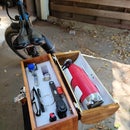Introduction: How to Convert a Tugboat to Live-aboard Part 1
How I converted a tired US Army tugboat into a yacht/tug. This project took 10 years to be 90% complete. Hardest part is finding a berth for something this big, at a reasonable price.
Step 1: Find a Suitable Candidate
Start by hunting around the waterfront. Hang out in dive bars. Comb Craigslist in the Seattle and SF Bay area sections. British Columbia has lots of great old tugs. Join the Retired Tugboat group on FB. Our search took us from San Diego to Vancouver. One of the first boats we considered seriously was an Army LT type tug (the LT-2080) Located at Rough and Ready island in Stockton Ca. that had been modified for use in atmospheric diffusion testing (read that chemical weapons testing) in a top secret project called SHAD. the problem with this boat was it glowed in the dark. So my wife and I wrote that one off our list.
We finally found our dreamboat in an add in Boats and Harbors, a newspaper style magazine dedicated to selling used marine equipment. Everyone loves an auction right? We had 7 others bidding against us including my best friend.
Step 2: Put the Main Engine Back Together, Build a New Galley
Spend the next month putting the main engine back together, get a friend to help you move the 1,200 pound cylinder heads around. Oh and the rest of the engine parts are in the galley. The Galley took the most amount of time for a single room. We started by ripping out the industrial galley, then we roughed in the plumbing and electrical.next we applied wood furring strips to the walls we later covered with mahogany plywood. The Tiled walls were prepared by covering them with 1/4" Hardy tile backer board. we used regular backer board screws with pre drilled and countersunk holes, screwing right into the steel walls (bulkheads). then after installing the appliances, a six burner SS range, dishwasher and 48' built in refrigerator, I built plywood boxes for the cabinets. Then we purchased the first thousand board feet of rough-sawn Honduras mahogany. we used this to build the doors and drawer fronts. For the countertops we used colored ferro cement. The refrigerator was a tad too tall, so we removed the compressor from the top and mounted it in the upper engine room (fiddly), behind the galley.
Step 3: Deckhouse Prep and Construction
Get an oxy acetylene cutting outfit then start cutting, the scrap metal people are going to love you by the time this is over. After you've cut away everything that doesn't look like a live aboard tug. Start building your deckhouse extensions.
Step 4: Spend the Next Ten Years Finishing Off the Interior
Here is a short video of the finished interior.













